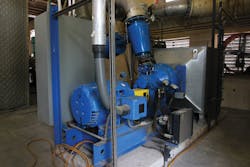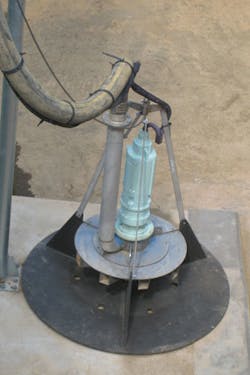| One of two Turblex blowers returned to service. Photo courtesy of LAN. |
Conroe Wastewater Treatment Plant
In the Conroe project, the existing blower systems utilized five multistage blowers designed for use with the plant’s original course bubble aeration system. These multistage blowers were installed when the plant was built in the late 1980s. Two single-stage, high-speed blowers were installed in 2006 when the plant was converted to fine bubble aeration as part of an energy savings project.
Unfortunately, the hydraulics of the plant were not adequately investigated for this energy savings project, and the variation in the liquid depth of the basin, which occurred with varying flow, prevented these blowers from being fully utilized. The plant ran the fine bubble aeration system utilizing one or two of the existing multistage blowers instead of operating the single-stage, high-speed blowers, which routinely shut down due to discharge pressure issues. The plant therefore used its existing multistage blowers to provide air to the fine bubble system. This operating strategy allowed the plant to meet discharge limits but did not attain the full potential for energy savings benefits.
As part of a larger renewal and renovation effort, LAN designed changes to modify the basin configuration, moving the hydraulic control point from the clarifier weirs to new weirs at the aeration basin. This change has allowed the water level in the aeration basins to remain much more constant. The single-stage, high-speed blowers can now operate 100 percent of the time. Understanding the problems with and solutions to the blower issues allowed further modifications to the biological process.
The plant originally utilized the step-feed process, but the implementation lacked adequate control. Recycle and raw influent lines and valves were gravity fed from distribution boxes. The gravity lines and valves were oversized, no flow monitoring or controls were provided, so the operators had to “eyeball” flow into each zone.
The process was changed to an anaerobic/oxic (AO) configuration, and as part of the aeration system modifications, the full-floor diffuser coverage was modified into three zones with a tapered configuration. These aeration diffuser changes, in combination with the hydraulic changes that allowed the single-stage, high-speed blowers to be utilized, provided the means by which a greater range of air demands could be met. Control has improved to the point that simultaneous nitrification/denitrification has been achieved. Extremely low ammonia and nitrate values are obtained without any internal recycle. The denitrification, in combination with the low dissolved oxygen concentrations that allow very efficient oxygen transfer, has enabled the plant to achieve a 25-percent reduction in energy use compared with operations prior to the renovation and renewal project. The savings have averaged $10,000/month for the past 16 months.
“The modifications have enabled us to use our two existing high-speed blowers we had all but given up on,” said Greg Hall, Jr., wastewater treatment plant superintendent for the City of Conroe. “The new controls and modifications work really well and have made the plant easier to operate with the added bonus of greater control of the aeration system.”




